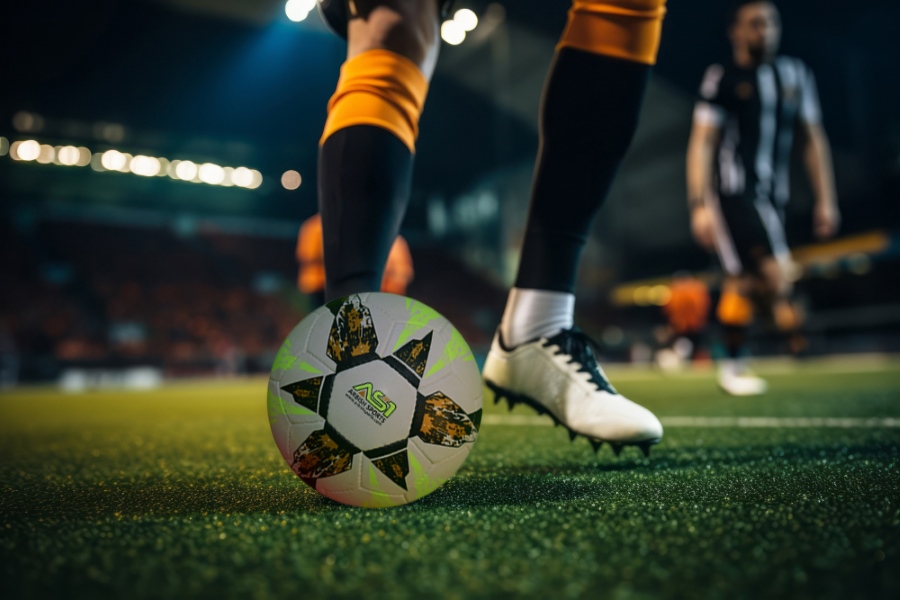How Deformation and Coefficient of Restitution (COR) Relates to the Performance Standards of FIFA Pro Soccer Balls

Table of Contents
ToggleSoccer balls are fascinating objects. They’re subjected to immense forces during gameplay, yet they maintain a surprising level of consistency in their performance. This all comes down to two key concepts: deformation and the coefficient of restitution (COR).
Deformation: The Temporary Change in Shape of Soccer Ball
Deformation refers to the temporary or permanent change in a soccer ball’s shape due to an applied force. This can occur when the ball is kicked, hit, or contacts any hard surface. Deformation affects the ball’s performance, including its bounce, trajectory, and durability.
Factors Influencing Deformation:
Force Applied: A harder kick will cause more deformation than a soft touch.
Inflation Pressure: A properly inflated ball will deform less than an underinflated or overinflated ball.
Ball Material: Different materials have varying elastic properties, affecting how much they deform and how quickly they return to their original shape. The quality and type of materials (e.g., synthetic leather, polyurethane, PVC) influence the ball’s ability to deform and recover.
Bladder: The inner bladder’s material (latex or butyl) and construction affect the ball’s elasticity and air retention.
Panel Construction: The number and type of panels (stitched, thermally bonded, or glued) impact the ball’s shape and deformation characteristics.
Pressure: Proper inflation is crucial. Under-inflated balls deform more easily and may not perform well, while over-inflated balls are more prone to damage and deformation.
Understanding deformation is essential for manufacturers and players to ensure the ball meets performance standards and provides a consistent playing experience.
Types of Deformation:
Elastic Deformation: This temporary change in shape occurs when the ball is kicked or pressed. The ball returns to its original shape once the force is removed. High-quality soccer balls are designed to exhibit elastic deformation, ensuring consistent performance and durability.
Plastic Deformation: This permanent change in shape happens when the ball is subjected to excessive force or pressure, beyond its capacity to return to its original shape. Plastic deformation can reduce the ball’s performance and indicate damage or lower quality.
Using the right size and weight ball and maintaining proper inflation pressure helps minimize plastic deformation and ensure optimal performance.
The Coefficient of Restitution (COR): How Much Bounce Does Your Ball Have?
Coefficient of Restitution (COR) measures a soccer ball’s elasticity, indicating how well the ball bounces back after hitting a surface. It is a ratio comparing the relative speeds of the ball before and after impact.
Key Points about COR:
Range: The COR value ranges between 0 and 1. A COR of 1 means a perfectly elastic collision where the ball bounces back without losing any energy. A COR of 0 indicates a perfectly inelastic collision where the ball does not bounce back at all.
Influence on Performance:
A higher COR means the ball retains more kinetic energy after impact, resulting in a higher bounce.
A lower COR means more energy is lost during impact, leading to a lower bounce.
Factors Affecting COR in a Soccer Ball Include:
Material Composition: The materials used in the ball’s construction, such as the outer cover, inner lining, and bladder, influence the COR. Higher quality materials typically provide better elasticity.
Construction: The design and manufacturing process, including the number of panels and how they are stitched or bonded, affect the ball’s bounce characteristics.
Air Pressure: Proper inflation is crucial. Over-inflated or under-inflated balls will have different COR values and therefore different bounce behaviors.
Temperature: Temperature can affect the elasticity of the materials, thus impacting the COR.
Friction: Friction between the ball and the surface it hits dissipates some energy.
Surface: The surface the ball bounces on (grass, turf, concrete) will also influence the COR.
While COR isn’t typically considered during regular play, it’s a factor during official testing for FIFA approval. A soccer ball needs to meet a minimum bounce height requirement to be certified.
Practical Considerations:
Testing COR: The COR is typically tested in a controlled environment where a ball is dropped from a specific height onto a hard surface, and the rebound height is measured. This data is used to calculate the COR.
Standards and Regulations: Soccer balls used in official matches must meet standards set by governing bodies like FIFA, which include specifications for COR to ensure consistency and fairness in play.
Understanding the COR is essential for manufacturers and players to ensure that soccer balls meet performance expectations and regulatory standards, providing a consistent and enjoyable playing experience.
FIFA Pro Ball Specifications and Maintenance Guidelines
Standard Circumference:
According to FIFA standards, the circumference of a professional soccer ball should be between 68 cm (26.8 inches) and 70 cm (27.6 inches).
Example:
A ball with a circumference of 69 cm (27.2 inches) fits well within the FIFA standards, ensuring it is suitable for professional matches.
Best Pressure for FIFA Pro Balls
Recommended Pressure:
The optimal pressure for a FIFA-approved soccer ball is between 0.6 and 1.1 bars (8.7 and 16.0 psi).
Example:
A ball inflated to 0.9 bars (13.0 psi) falls within the recommended range, ensuring it has the right balance of firmness and elasticity for professional play.
FIFA Standard for Pressure Retention Over 7 Days:
A high-quality FIFA Pro ball should retain its pressure well over time. FIFA requires that a soccer ball should not lose more than 20% of its initial pressure after 7 days.
Example:
If a ball is initially inflated to 1.0 bar (14.5 psi), it should not drop below 0.8 bars (11.6 psi) after 7 days to meet FIFA standards.
Tips for Maintaining Pressure:
- Ensure the valve is properly sealed and not leaking.
- Store the ball in a cool, dry place away from direct sunlight to prevent pressure loss due to temperature changes.
- Regularly check and adjust the pressure to maintain optimal performance.
FIFA Sphericity Standard: Managing Sphericity Deviation
The circumference of the ball should not deviate in sphericity by more than 1%. This means the maximum difference between the smallest and largest circumference should be less than 1% of the ball’s average circumference.
Example:
For a ball with an average circumference of 69 cm (27.2 inches), the deviation should be less than 0.69 cm (0.27 inches). If the smallest circumference is 68.7 cm (27.05 inches) and the largest is 69.3 cm (27.28 inches), the ball meets the sphericity standard.
Maintaining Sphericity:
Material Quality: Use high-quality materials such as synthetic leather and ensure the inner bladder is made from durable materials like latex or butyl.
Manufacturing Precision: Employ advanced manufacturing techniques to ensure even panel construction and stitching. Thermally bonded or machine-stitched balls generally offer better sphericity.
Quality Control: Conduct regular inspections and quality control tests during and after production to ensure each ball meets the sphericity standards. Use precise measuring tools to check the circumferences.
By adhering to these guidelines and standards, manufacturers can produce high-quality soccer balls that meet FIFA’s stringent requirements for professional play. Regular maintenance and careful handling also ensure the balls perform optimally throughout their lifespan.
- Facebook
- Twitter
- Linkedin
- Whatsapp





